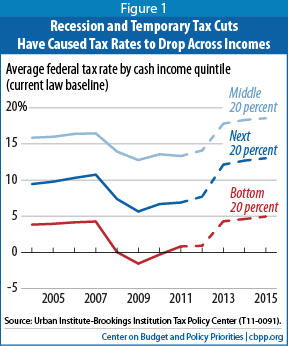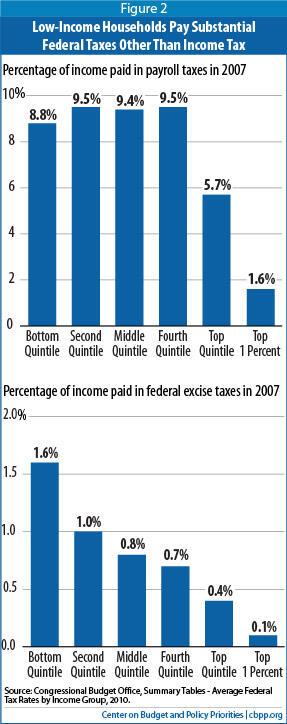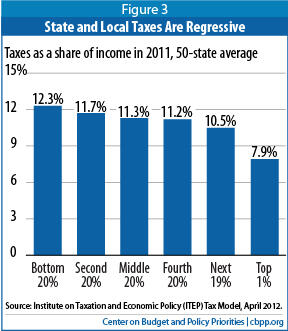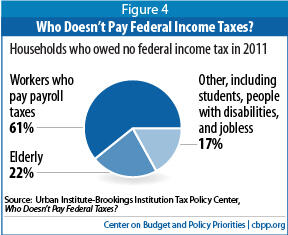Close to half of U.S. households currently do not owe federal income tax. The Urban Institute-Brookings Tax Policy Center estimates that 46 percent of households will owe no federal income tax for 2011. [1] A widely cited figure is a Joint Committee on Taxation estimate that 51 percent of households paid no federal income tax in 2009.[2] (The TPC figure for 2009 also is 51 percent.) [3]
These figures are sometimes cited as evidence that low- and moderate-income families do not pay sufficient taxes. Yet these figures, their significance, and their policy implications are widely misunderstood.
- The 51 percent and 46 percent figures are anomalies that reflect the unique circumstances of the past few years, when the economic downturn greatly swelled the number of Americans with low incomes. The figures for 2009 are particularly anomalous; in that year, temporary tax cuts that the 2009 Recovery Act created — including the “Making Work Pay” tax credit and an exclusion from tax of the first $2,400 in unemployment benefits — were in effect and removed millions of Americans from the federal income tax rolls. Both of these temporary tax measures have since expired.
In 2007, before the economy turned down, 40 percent of households did not owe federal income tax. This figure more closely reflects the percentage that do not owe income tax in normal economic times.[4] - These figures cover only the federal income tax and ignore the substantial amounts of other federal taxes — especially the payroll tax — that many of these households pay. As a result, these figures greatly overstate the share of households that do not pay federal taxes. Tax Policy Center data show that only about 17 percent of households did not pay any federal income tax or payroll tax in 2009, despite the high unemployment and temporary tax cuts that marked that year.[5] In 2007, a more typical year, the figure was 14 percent. This percentage would be even lower if it reflected other federal taxes that households pay, including excise taxes on gasoline and other items.
- Most of the people who pay neither federal income tax nor payroll taxes are low-income people who are elderly, unable to work due to a serious disability, or students, most of whom subsequently become taxpayers. (In years like the last few, this group also includes a significant number of people who have been unemployed the entire year and cannot find work.)
- Moreover, low-income households as a group do, in fact, pay federal taxes. Congressional Budget Office data show that the poorest fifth of households paid an average of 4.0 percent of their incomes in federal taxes in 2007, the latest year for which these data are available — not an insignificant amount given how modest these households’ incomes are; the poorest fifth of households had average income of $18,400 in 2007.[6] The next-to-the bottom fifth — those with incomes between $20,500 and $34,300 in 2007 — paid an average of 10.6 percent of their incomes in federal taxes.
- Moreover, even these figures greatly understatelow-income households’ totaltax burden because these households also pay substantial state and local taxes. Data from the Institute on Taxation and Economic Policy show that the poorest fifth of households paid a stunning 12.3 percent of their incomes in state and local taxes in 2011.[7]
- When all federal, state, and local taxes are taken into account, the bottom fifth of households pays about 16 percent of their incomes in taxes, on average. The second-poorest fifth pays about 21 percent.[8]
It also is important to consider who the people are who do not owe federal income tax in a given year.
- TPC estimates show that 61 percent of those that owed no federal income tax in a given year are working households.[9] These people do pay payroll taxes as well as federal excise taxes, and, as noted, state and local taxes. Most of these working households also pay federal income tax in other years, when their incomes are higher — which can be seen by looking at the low-income working households that receive the Earned Income Tax Credit (EITC).
- The leading study of this issue found that the majority of households that receive the EITC get it for only one or two years at a time, such as when their income drops due to a temporary layoff, and pay federal income tax in most other years. The study examined the filers who claimed the EITC at least once during an 18-year periodand found that they paid a net of several hundred billion dollars in federal income tax over that period.[10] This finding shows that while some households will receive refundable tax credits in a given year whose value may exceed their payroll tax liability, they pay significant federal income taxes over time in addition to the payroll and state and local taxes they pay each year.
- The remainder of those who pay no income tax are primarily elderly, disabled, or students.
The fact that most people who don’t owe federal income tax in a given year pay substantial amounts of other taxes — and also are net income taxpayers over time — belies the claim that households that do not owe income tax in a given year will form bad policy judgments because they “don’t have any skin in the game.”
Furthermore, although the federal tax system is progressive overall, state and local tax systems are regressive and undo a significant share of that progressivity. There is nothing wrong with having one part of the overall tax system shield low- and moderate-income households, who pay substantial amounts of other taxes and generally pay federal income tax as well in other years.
To substantially increase the share of households that owe federal income tax, policymakers would have to take such steps as: lowering the personal exemption or standard deduction — which would tax many low-income working families into, or deeper into, poverty; weakening the EITC or Child Tax Credit, which would significantly increase child poverty while reducing incentives for work over welfare; or paring back the tax exclusion for Social Security benefits, which would subject more seniors with modest fixed incomes to the income tax.
This analysis now explores these issues in more detail.
In 2007, before the economy turned down, the share of households with no federal income tax liability stood at 40 percent.[11] In 2009, two factors combined to cause a large, temporary spike in the share of Americans with no net federal income tax liability — the recession, which reduced many people’s incomes, and several temporary tax cuts that have since expired. The 51 percent figure for 2009 reflected these temporary factors.
- Recession-induced decline in incomes. In 2009, unemployment was at its highest level in many years and rising sharply, and incomes were falling. Income tax liabilities are designed to adjust to these cyclical factors, rising when the economy is strong and falling when it is weak; this automatic adjustment helps to stabilize the economy by cushioning the drop in people’s after-tax incomes — and thus their spending — during a downturn. One consequence of the economic downturn was a sharp decline in both federal and state tax receipts, as millions of workers lost their jobs or had their work hours reduced. For many Americans, the loss of income meant that while they owed federal income taxes in previous years, they did not in 2009.
- Temporary tax cuts. Policymakers responded to the deep economic contraction by enacting policies to stimulate consumer demand, including targeted public investments and temporary tax cuts that removed millions more Americans from the tax rolls. Roughly 95 percent of working families benefited from the Recovery Act’s Making Work Pay tax credit, which reduced their federal income tax liability in both 2009 and 2010 by $400 for individuals and $800 for married couples. For some of these people, this tax credit eliminated their federal tax liability entirely. Other temporary income tax cuts, including the exclusion of the first $2,400 in unemployment insurance benefits and a first-time homebuyer tax credit, eliminated federal income tax liability for additional taxpayers in 2009.
In other words, the federal income tax system did what it is supposed to do during the recession — take a smaller bite out of people’s incomes. As the temporary tax cuts expire and the economy and incomes strengthen, people’s tax liabilities will rebound (see Figure 1). For example, the Tax Policy Center estimates that the share of households with no federal income tax liability declined to 46.4 percent in 2011, when the aforementioned income tax cuts were no longer in effect (and the unemployment rate was a slight bit below the 2009 level).
[12] As the still elevated unemployment rate declines, this percentage will fall further.
The notion that “half of Americans don’t pay taxes” not only overstates the share of households that do not pay federal income taxes in a typical year. It also ignores the other taxes people pay, including federal payroll taxes and state and local taxes. Policymakers, pundits, and others sometimes overlook this point.
At a Senate Finance Committee hearing in May 2011, Senator Charles Grassley said, “According to the Joint Committee on Taxation, 49 percent of households are paying 100 percent of taxes coming in to the federal government” (meaning that the other 51 percent pay no federal tax whatsoever). At the same hearing, Cato Institute Senior Fellow Alan Reynolds asserted, “Poor people don’t pay taxes in this country.” In 2010, Fox Business host Stuart Varney said on Fox and Friends, “Yes, 47 percent of households pay not a single dime in taxes.”[13]
None of these assertions are correct. As the Tax Policy Center’s Howard Gleckman noted regarding a TPC estimate that almost half of Americans owed no federal income tax in 2009, “rarely has a bit of data been so misunderstood, or so misused.” Gleckman wrote:
Let me explain — repeat actually — what [the figure] means: About half of taxpayers paid no federal income tax last year. It does not mean they paid no tax at all. Many shelled out Social Security and Medicare payroll taxes. [….] Some paid property taxes and, it is fair to say, just about all of them paid sales taxes of one kind or another. So to say they pay no taxes is flat wrong.[14]
The reality is that the income tax is one of a number of types of taxes that individuals pay, both over the course of their lifetimes and in a given year, and it makes little sense to treat it as though it were the only tax that matters. Some 82 percent of working households pay more in payroll taxes than in federal income taxes.[15] In fact, low- and moderate-income people pay a much larger share of their incomes in federal payroll taxes than high-income people do: taxpayers in the bottom 20 percent of the income scale paid an average of 8.8 percent of their incomes in payroll taxes in 2007, compared to 1.6 percent of income for those in the top 1 percent of the income distribution (see Figure 2).[16]
There are two reasons why this is the case: high-income taxpayers generate much larger shares of their incomes than other households do from sources such as capital gains and dividends that aren’t subject to the Social Security payroll tax;[17] and earnings above $110,100 in 2012 aren’t subject to the Social Security tax. That means that, as Aviva Aron-Dine wrote in a recent Milken Review article, “dishwashers pay a larger share of income in payroll taxes than, say, neurosurgeons.”[18]
Taking payroll taxes into account, in 2009, some 83 percent of filers paid either some federal payroll or some federal income tax. In 2007, the most recent non-recession year, 86 percent of filers paid either some federal payroll or some federal income tax.[19]
In addition, Congressional Budget Office data show that lower-income households pay a significantly larger share of their incomes in federal excise taxes (levied on goods such as gasoline) than middle- and upper-income households do.
When all federal taxes are considered, it is clear that the overwhelming majority of Americans pay such taxes. CBO data show that the poorest fifth of households paid an average of 4 percent of their incomes in federal taxes despite their low incomes in 2007, while the next fifth paid an average of 10 percent of income in federal taxes.
Low-income families also pay substantial state and local taxes. Most state and local
taxes are regressive, meaning that low-income families pay a larger share of their incomes in these taxes than wealthier households do. The bottom fifth of taxpayers paid 12.3 percent of their incomes in state and local taxes in 2011, according to the Institute on Taxation and Economic Policy (ITEP).[20] That was well above the 7.9 percent average rate that the top 1 percent of households paid (see Figure 3).
Considering all taxes — federal, state, and local — the bottom 20 percent of households pays an average of 16 to 17 percent of their incomes in taxes. The next 20 percent of households pays about 21 percent of income in taxes, on average. [21]
In fact, when all taxes are considered, the share of taxes that each fifth of households pays is similar to its share of the nation’s total income.
[22] ITEP data show that in 2011, the bottom fifth of households received 3.4 percent of the total income in the nation and paid 2.1 percent of the total taxes. The middle fifth of households received 11.4 percent of income and paid 10.3 percent of taxes. The top 1 percent of households received 21.0 percent of income and paid 21.6 percent of taxes. The tax system as a whole is only mildlyprogressive.
[23] Some have implied or suggested that people who do not owe federal income tax are “freeloaders” who don’t have a “stake in the system,” and that making them pay federal income taxes would improve the tax code.
Yet the vast majority of the people who owe no federal income taxes fall into one of three categories (see Figure 4):[24]
- Approximately 61 percent are working people who pay payroll taxes. As noted above, even the low-income households in this group pay substantial federal income taxes over time. The main options to force these people to pay federal income tax in years when their incomes are low include cutting the EITC or the Child Tax Credit, which would tend to reduce work incentives and increase child poverty and welfare use, and lowering the standard deduction or personal exemption, which could tax many low-income working families into, or deeper into, poverty.
-
An additional 22 percent of people who did not pay federal income taxes in 2009 are people aged 65 or older who have modest incomes (and do not have earnings). The main option to make these individuals pay federal income tax would be to subject their Social Security benefits to taxation despite their limited income.[25]
- The remaining 17 percent includes students, people with disabilities or illnesses, the long-term unemployed, and other people with very low taxable incomes. To make these people pay federal income taxes, policymakers would have to tax disability, veterans’, and similar benefits or make full-time students and the long-term jobless individuals borrow (or draw from any available savings) to pay taxes on their meager incomes.
As Urban Institute analyst Elaine Maag has written of non-income taxpayers, “most are elderly, poor, or unemployed (including people who are too disabled to work). Whom, I wonder, should the tax man put on the block?”[26]
A separate TPC analysis categorized people who do not owe federal income tax in 2011 in a different way.* It found that of the filers who don’t owe federal income tax for 2011:
- 50 percent are in this category because their incomes are so low that they are less than the sum of the standard deduction and personal and dependent exemptions for which the household qualifies. As TPC Senior Fellow Roberton Williams has noted, “the basic structure of the income tax simply exempts subsistence levels of income from tax.”** Some 62 percent of the households who will owe no federal income tax in 2011 have incomes under $20,000.
- Another 22 percent do not owe federal income tax because they are elderly people who benefit from tax provisions to aid senior citizens, such as the exemption of Social Security benefits from income tax for beneficiaries who have incomes below $25,000 for single filers and $32,000 for joint filers and the higher standard deduction for the elderly.
- Another 15 percent (of the households who don’t owe federal income tax) don’t owe the tax because they are low-income working families with children who qualify for the child tax credit, the child and dependent care tax credit, and/or the earned income tax credit, and the credit(s) eliminate their income tax liability.***
* Rachel Johnson, James Nunns, Jeffrey Rohaly, Eric Toder, and Roberton Williams, “Why Some Tax Units Pay No Income Tax”, Urban-Brookings Tax Policy Center, July 2011; and Roberton Williams, “Why Do people Pay No Federal Income Tax” TPC TaxVox, July 27, 2011. For a further discussion of this TPC analysis, see Aviva Aron-Dine, “Trends”, Milken Institute Review, First Quarter 2012, pp. 5-11.
** Roberton Williams, “Why Do People Pay No Federal Income Tax?”, TPC TaxVox, July 27, 2011
*** The remainder of those who do not owe federal income tax, about 13 percent, don’t owe federal income tax because of itemized deductions or other tax benefits.
From its roots as an idea from conservative economist Milton Friedman several decades ago, the Earned Income Tax Credit has become an increasingly important tool to make work pay more than welfare and enough to lift people working full time at the minimum wage out of poverty. Research has demonstrated the EITC’s effectiveness. Nobel laureate (and noted conservative economist) Gary S. Becker has written, “Empirical studies confirm . . . that the EITC increases the labor force participation and employment of people with low wages because they need to work in order to receive this credit.”[27] (Becker also has applauded the EITC for being “fully available to families with both parents present, even where only one works and the other cares for their children [i.e., for being available to low-income working families with stay-at-home mothers].”)
Studies of the EITC expansions enacted in the 1980s and 1990s found those expansions induced more than half a million people to enter the labor force. One prominent study identified the EITC as “a particularly important contributor to both the recent decrease in welfare use and the recent increase in employment, labor supply, and earnings” among female-headed families.[28] The creation of the refundable component of the Child Tax Credit, which like the EITC is available only to families that work, has complemented the EITC’s pro-work efforts. Moreover, the EITC and CTC lifted 8.9 million people — including 4.7 million children — out of poverty in 2010.[29] These refundable credits lift more children out of poverty than any other program or category of programs at any level of government.
Several factors reinforce the importance of these credits in promoting and rewarding low-wage work. In recent decades, incomes in the United States have grown increasingly unequal, with the lion’s share of the economic gains from globalization, advances in technology, and the like accruing to those on the upper rungs of the income ladder. CBO data show that the average income among people in the lowest income fifth was $17,700 in 2007; if all incomes had grown at the same rate since 1979, that figure would have been $6,000 higher. Our economy benefits from globalization and technological change, but there are winners and losers. The refundable tax credits help to offset a portion of the effects of the stagnation of wages at the bottom of the income spectrum.
In addition, the weak labor market is likely to continue exerting downward pressure on wages over the next several years. The unemployment rate remains stubbornly high, at 8.2 percent in March 2012. CBO projects that it will not drop to under 6 percent until 2017. Taking note of the bleak employment picture facing out-of-work men, columnist David Brooks wrote last year that “wage subsidies” should be on the list of future policy responses. The EITC is a much-needed wage subsidy for low-income workers (although the EITC for poor workers without children remains very small and should be strengthened).
Finally, over the past several decades, policymakers have essentially relied more on the EITC to supplement low wages and less on the minimum wage, which they have allowed to decline by 19 percent in purchasing power since its peak in 1968 (i.e., the minimum wage has fallen by 19 percent in inflation-adjusted dollars).
For all of these reasons, scaling back the EITC in order to require more low-income working families to pay federal income taxes in years when their incomes are low would be a significant step backward, discouraging work and increasing poverty.
Corporations and Small Business Owners
Also Pay No Income Tax During Bad Years
As this analysis notes, in addition to paying other taxes each year (many of which involve significant tax burdens), most people who do not pay federal income tax in a given year do pay that tax over time. For example, more than half of the tax filers who received the EITC between 1989 and 2006 received the credit for no more than a year or two at a time and generally paid substantial amounts of federal income tax in other years. The taxpayers who claimed the EITC during this 18-year period paid several hundred billion dollars in net federal income tax over that period (in 2006 dollars) even after taking the EITC payments they received into account. *
The tax-paying record of both large corporations and small businesses follows an analogous pattern — in some years no taxes are paid, while in other years substantial taxes are paid. During the years when they have net operating losses, companies that are subject to the corporate income tax generally have no tax liability.
A GAO study found that in every year from 1998 to 2005, approximately 55 percent of large corporations paid no corporate income tax. ** But just 2.7 percent of large corporations reported no net tax liability in all eight of those eight years. This reflects a similar pattern as applies to families and individuals — those who do not pay income tax in a given year often do pay income tax over time.
This pattern also applies to small business owners and others who deduct business losses from their taxable incomes and thereby eliminate their income tax liability in some years.
* Tim Dowd and John B. Horowitz, “Income Mobility and the Earned Income Tax Credit: Short-Term Safety Net or Long-Term Income Support,” Public Finance Review (April 11 2011), pp 619-652; CBPP communications with authors.
** Large corporations are those with at least $250 million in assets or $50 million in gross receipts. Government Accountability Office, “Comparison of the Reported Tax Liabilities of Foreign- and U.S.-Controlled Corporations, 1998-2005,” July 2008, http://www.gao.gov/new.items/d08957.pdf.





